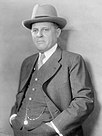Hare–Hawes–Cutting Act
 | |
| Long title | An act envisageing a 10-year transitory period during which time the Philippines would establish a semi-autonomous government under an elected Filipino president. |
|---|---|
| Enacted by | the 72nd United States Congress |
| Legislative history | |
| |
The Hare–Hawes–Cutting Act[1] passed to authors Congress Butler B. Hare, Senator Harry B. Hawes and Senator Bronson M. Cutting. (ch. 11, 47 Stat. 761, enacted January 17, 1933) The Hare–Hawes–Cutting Act was the first US law passed setting a process and a date for the Philippines to gain independence from the United States. It was the result of the OsRox Mission led by Sergio Osmeña and Manuel Roxas. The law promised Philippine independence after 10 years but reserved several military and naval bases for the United States, as well as imposed tariffs and quotas on Philippine imports.
History
[edit]By 1932, two main groups supported a law outlining the specifics of Philippine independence: Great Depression-era American farmers competing against tariff-free Filipino sugar and coconut oil; and Filipinos seeking Philippine independence. The Hare–Hawes–Cutting Act was authored by South Carolina Representative Butler Hare, Missouri Senator Harry Bartow Hawes and New Mexico Senator Bronson M. Cutting. It passed by the United States Congress in December 1932 but was vetoed by U.S. President Herbert Hoover. Congress overrode the veto on January 17, 1933. The Philippine Senate was required to ratify the law. With leaders such as Manuel L. Quezon opposing it, for some provisions were unrelated to independence. The Philippine Senate later rejected the bill.[2]
Bill
[edit]The bill itself proposed to have a 10-year transitionary period where the government will establish a semi-autonomous government under an elected president.[3]
Aftermath
[edit]After the rejection, a new bill, the Tydings–McDuffie Act of 1934, was passed by the United States Government. This was ratified by the Philippine Senate for eliminating the rejection reasons and resulted in the 1935 Philippine Constitution, the establishment of the Philippine Commonwealth and ultimately Philippine independence on July 4, 1946.[4]
See also
[edit]- Political history of the Philippines
- History of the Philippines
- Philippine Organic Act (1902)
- Jones Law (Philippines) or the Philippines Autonomy Act (1916)
References
[edit]- ^ "Hare–Hawes–Cutting Act: United States history". Britannica.com. 20 July 1998.
- ^ Sicat, Gerardo P. "'Manuel L. Quezon: How he secured the independence law from the United States'". Philstar.com. Retrieved 2024-09-06.
- ^ "July 4, 1946: The Philippines Gained Independence from the United States". The National WWII Museum | New Orleans. 2021-07-02. Retrieved 2024-09-06.
- ^ "The Hare Hawes-Cutting Act was passed January 13, 1933". The Kahimyang Project. 2012-01-12. Retrieved 2024-09-06.



